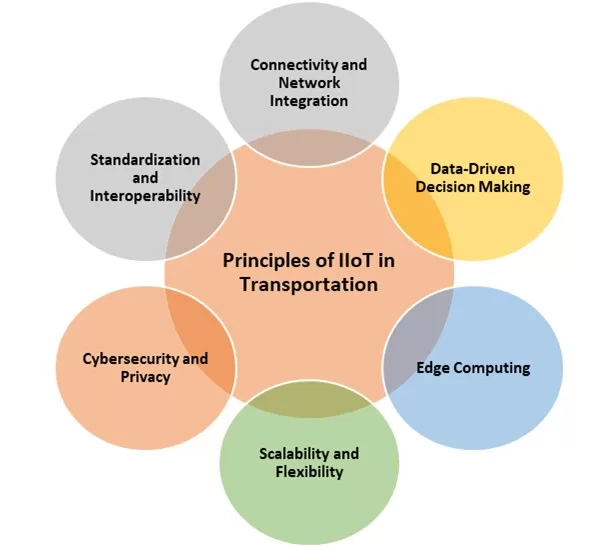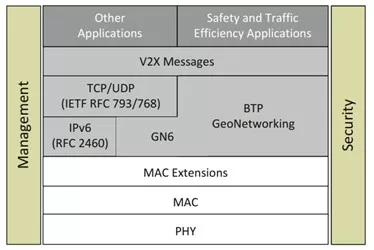Introduction
The Industrial Internet of Things (IIoT) influence permeates through various sectors, with the transportation domain standing out as a prime example of its transformative potential. Intelligent Transportation Systems (ITS), underpinned by IIoT, represent a paradigm shift in how vehicular traffic and transportation infrastructure are managed, optimized, and propelled into the future.
Principles of IIoT in Transportation
The integration of the Industrial Internet of Things (IIoT) within transportation systems is predicated on several core principles that are tailored to enhance and redefine the operational landscape of this sector. These principles serve as the bedrock for intelligent transportation systems (ITS) and are critical for realizing the vision of a connected and automated mobility future.

Figure 1: Principles of IIoT in Transportation
- Connectivity and Network Integration At the heart of IIoT in transportation is the seamless connectivity across various devices and systems. This is achieved through advanced communication protocols, which enables vehicles to communicate with each other and with roadside infrastructure in real time.
- Data-Driven Decision Making Data is the lifeblood of IIoT systems, and in transportation, the collection, analysis, and application of data are vital. Sensors deployed across vehicles and infrastructure collect a vast amount of data on traffic patterns, vehicle behavior, and environmental conditions. Advanced analytics and machine learning algorithms process this data to make predictive decisions that enhance traffic flow, reduce congestion, and improve overall transportation efficiency.
- Edge Computing The latency-sensitive nature of transportation applications necessitates processing at the edge of the network. Edge computing allows for immediate data processing near the source, which is essential for time-critical applications such as collision avoidance systems. By minimizing the distance data travels for processing, edge computing enhances the responsiveness of ITS.
- Scalability and Flexibility IIoT systems in transportation must be scalable to handle the growing number of connected vehicles and infrastructure components. They also need to be flexible to adapt to the evolving technological landscape and changing regulatory requirements. The modular and interoperable design of IIoT architectures enables this scalability and flexibility, allowing systems to expand and evolve as needed.
- Cybersecurity and Privacy With the increasing connectivity in transportation systems, cybersecurity becomes paramount. The secure exchange of information is critical to protect against cyber threats and to ensure user privacy. IIoT systems are designed with robust security protocols to safeguard communication and data integrity.
- Standardization and Interoperability The effectiveness of IIoT in transportation is contingent upon standardized technologies that ensure interoperability between different systems and devices. These core principles lay the foundation upon which IIoT transforms transportation into an interconnected, intelligent network capable of meeting the dynamic demands of modern mobility while addressing key challenges such as safety, efficiency, and sustainability.
IIoT-Enhanced V2X Communication Systems
The integration of the Industrial Internet of Things (IIoT) within vehicular communications, often referred to as Vehicle-to-Everything (V2X) systems, heralds a transformative era in transportation technology. IIoT-enriched V2X systems extend the concept of connectivity beyond traditional mobile networks to a broader ecosystem of smart transportation.
IIoT-enhanced V2X systems are architected to leverage a mesh of sensors, devices, and edge computing resources distributed throughout transportation networks. This integrated framework allows for an unprecedented level of situational awareness and control, facilitating real-time data acquisition and processing at the edge of the network, nearest to where the data is generated.
At the heart of IIoT-enhanced V2X is data-driven decision-making. By harnessing vast streams of data from a variety of sources such as vehicles, infrastructure, and pedestrians, these systems provide actionable insights for traffic management, route planning, and autonomous vehicle operations. The synthesis of this data is instrumental in predictive analytics, which can anticipate and mitigate traffic congestions and incidents.
Safety is paramount in transportation, and IIoT-enhanced V2X systems are equipped with sophisticated safety mechanisms. These include collision avoidance protocols, real-time hazard notifications, and the facilitation of autonomous vehicle safety features. The systems leverage the low-latency communication provided by technologies such as DSRC and ETSI ITS G5 to deliver instant warnings and responses to potential safety threats.
Introduction to DSRC/ETSI ITS G5
Dedicated Short-Range Communications (DSRC), along with the European Telecommunications Standards Institute’s Intelligent Transport Systems (ETSI ITS) G5, represent a fundamental aspect of the Industrial Internet of Things (IIoT) in the domain of transportation. These technologies provide the critical communication infrastructure necessary for the implementation of intelligent transportation systems (ITS).


Figure 2: DSRC & ETSI C-ITS protocol stack
Technological Foundation
DSRC is based on IEEE 802.11p, an amendment to the IEEE 802.11 standard that allows for wireless access in vehicular environments. It operates in the 5.9 GHz band dedicated to automotive communication. This specialized form of Wi-Fi facilitates vehicle-to-everything (V2X) communications, which is a cornerstone for the development of automated and connected vehicles.
The ETSI ITS G5 and DSRC protocols are designed to support low latency communications, which are essential for safety-critical applications. The sub-millisecond latency allows for real-time alerts and rapid information exchange between vehicles and infrastructure, which is paramount for collision avoidance, traffic management, and dynamic route optimization.
One of the significant advantages of DSRC/ETSI ITS G5 is their efficient use of spectrum and bandwidth. These technologies are tailored to transmit short, high-priority messages with minimal overhead, making them well-suited for the transmission of safety and operational data in high-density traffic situations.
Security and Standards Protocols
Security is inherently designed into the DSRC/ETSI ITS G5 standards, featuring advanced cryptographic mechanisms for authentication and confidentiality. These protocols ensure that only verified devices can participate in the network, protecting against unauthorized access and tampering with communication.
The standardization of DSRC and ETSI ITS G5 ensures interoperability, meaning that vehicles and roadside units (RSUs) from different manufacturers and countries can communicate with each other. This is crucial for the seamless operation of vehicles across various regions and facilitates international travel and trade.
These technologies are the building blocks of Cooperative Intelligent Transport Systems (C-ITS), where vehicles and infrastructure collaboratively work to improve traffic efficiency and road safety. By sharing information on traffic conditions, incidents, and roadwork, DSRC/ETSI ITS G5 enable a cooperative approach to transportation management.
Interoperability Challenges and IIoT Solutions
The advancement of Intelligent Transport Systems (ITS) through IIoT brings forth the promise of seamless transportation networks. However, this integration faces significant interoperability challenges that stem from the diversity of devices, protocols, and standards. Addressing these challenges is crucial to realize the full potential of IIoT in transportation.
Heterogeneous Systems and Standardization A primary challenge in IIoT for transportation is the heterogeneity of systems and devices, which often operate on different communication protocols. IIoT solutions must focus on the development and adoption of industry-wide standards to ensure compatibility and interoperability. Standardization bodies like the IEEE, ETSI, and ISO are actively working to define unified frameworks such as IEEE 802.11p for DSRC, which fosters a common language for V2X communication.
Data Integration and Management Another challenge lies in the integration of data from various sources and formats. IIoT solutions must provide robust data management platforms that can aggregate, normalize, and analyze disparate data streams, enabling cohesive decision-making processes. Advanced middleware and data brokering services have been engineered to bridge this gap, offering the translation and routing of data between different systems.
Cybersecurity and Privacy Interoperability also brings about increased risks of cyber threats and privacy breaches. IIoT systems must incorporate strong cybersecurity protocols and employ encryption and authentication mechanisms to safeguard data and privacy. Blockchain technology is being explored as a means to provide secure and transparent data exchanges across an interoperable network.
Legacy Infrastructure Integration The modernization of existing transportation infrastructure to support IIoT poses its own set of challenges. Retrofitting legacy systems with IIoT capabilities requires innovative solutions that can interface with older technologies while introducing the benefits of connected systems. Modular and adaptable IIoT devices equipped with various communication technologies (such as RFIDs, LTE, and Wi-Fi) are key to this transition.
Scalability and Reliability As transportation systems grow and become more complex, maintaining scalability and reliability is paramount. IIoT architectures must be designed to scale horizontally and vertically while ensuring consistent performance. Cloud computing and edge computing are instrumental in this aspect, providing the necessary computational resources and reducing latency for time-sensitive operations.
Spectrum and Bandwidth Limitations Wireless communication systems such as DSRC/ETSI ITS G5 face spectrum and bandwidth constraints that can impact interoperability. Dynamic spectrum management and the use of cognitive radio technologies are IIoT solutions aimed at optimizing the use of available spectrum and ensuring that different systems can communicate effectively without interference.
Geographic and Regulatory Divergence Geographic differences and divergent regulatory frameworks can hinder the deployment of harmonized IIoT systems. Cross-border collaborations and international consortia are vital in overcoming these challenges by promoting harmonization in regulations and fostering a global approach to intelligent transportation systems.
User Adoption and Public Acceptance Finally, the user adoption and public acceptance of new IIoT systems are crucial for interoperability. Ensuring that the benefits of such systems are clearly communicated and that user interfaces are intuitive and accessible is essential for widespread acceptance. Public-private partnerships and educational initiatives can drive awareness and trust in IIoT-enhanced transportation systems.
In addressing these challenges, the role of IIoT as a unifying force in transportation becomes evident. Through continued innovation and collaboration, IIoT solutions can forge a path to fully interoperable, efficient, and secure transportation networks that cater to the needs of modern societies and economies.
ConclusionTop of Form
The integration of IIoT into transportation systems, manifested in Intelligent Transportation Systems (ITS), represents a significant leap in managing and optimizing vehicular traffic and infrastructure. As these systems become increasingly connected and data-centric, they offer enhanced operational efficiency and set the stage for a future where mobility is interconnected, intelligent, and responsive to the dynamic demands of modern society.
These systems are not only about connectivity but also about making informed decisions based on the vast data collected by sensors deployed across the network. By utilizing advanced analytics and processing this data at the edge of the network, ITS can deliver real-time responses crucial for applications like collision avoidance.
However, the integration of IIoT in transportation is not without its challenges. Issues of interoperability, data management, cybersecurity, and the integration of legacy systems are just a few of the hurdles that need to be overcome. The solutions involve a concerted effort toward standardization, the development of robust data platforms, and innovations that ensure the scalability and reliability of transportation systems.
As the transportation sector continues to evolve, the role of IIoT as a catalyst for innovation and progress becomes increasingly clear, promising a new horizon for intelligent mobility.
References
- 3GPP ETSI TS 23.501. System Architecture for the 5G System (5GS). V16.6.0, 2021-10.
- Nurul Huda Mahmood, Nikolaj Marchenko, Mikael Gidlund, Petar Popovski, “Wireless Networks and Industrial IoT”, Springer, https://doi.org/10.1007/978-3-030-51473-0
- Lauridsen, I. Z. Kovacs, P. Mogensen, M. Sorensen and S. Holst, “Coverage and Capacity Analysis of LTE-M and NB-IoT in a Rural Area,” 2020 IEEE 84th Vehicular Technology Conference (VTC-Fall), Montreal, QC,

